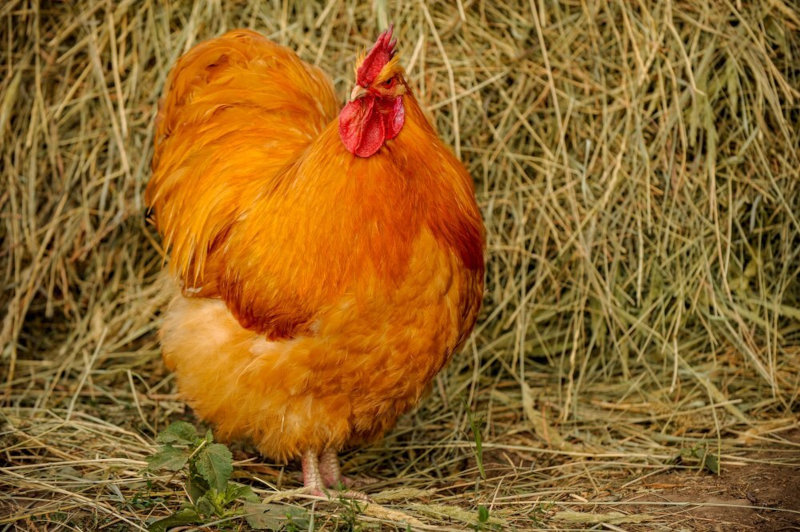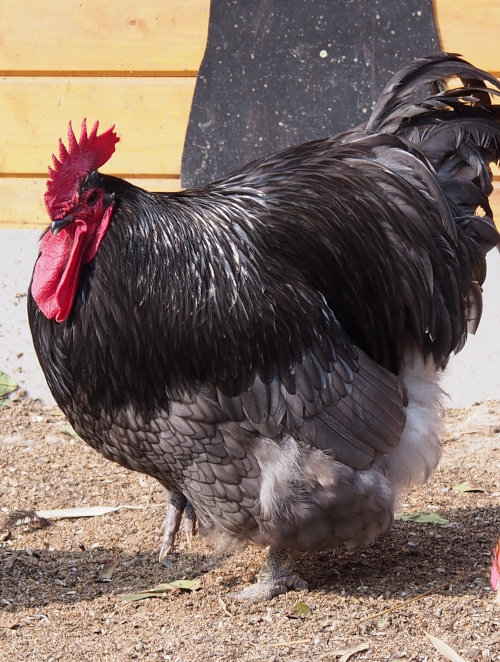Orpington chicken breed standards.

What should Orpington chickens look like?
The Orpington is a heavy set chicken with a broad deep body. The heavy and fluffy feathering on the Orpington makes them look very large and gives the appearance of a low stance. Feet and legs are free from feathers and should be pinkish white.
Below: Quality blue Orpington:

The standards of perfection for Orpington chickens :
There are 4 standardised colours in the UK (Black, Buff, Blue and White) the Buff Orpington is one of the most popular varieties, the Blue and Black Orpington are the largest.
They are heavy birds and carry a lot of fluffy feathering. The show strains have feathering that covers their legs, almost to their feet.
There are still some utility Orpingtons around that look distinctively different (see photos of Buff Orpingtons for an example) but it is very hard to find strains that will lay more than about 160 eggs per year.
These days, White Orpingtons are usually the best layers, some good strains laying up to 200 eggs per year. Orpington Hens usually go broody easily and make very good mothers.
The Carriage - is Bold, upright and graceful and the birds are active fowl.
Type - Body deep, broad and cobby with the back nicely curved with a somewhat short, concave outline.
Saddle - wide and slightly rising with full hackle.
Breast - Broad, deep and well rounded, not flat.
Wings - Small, nicely formed and carried closely to the body, the ends almost hidden by the saddle hackle.
Tail – Somewhat short, compact, flowing and high, but by not a squirrel tail.
Head - Small and neat, fairly full over the eyes.
Beak - strong and nicely curved.
Eyes - large and bold.
Comb - single, small, firmly set on head, evenly serrated and free from side sprigs. narrowing behind to a distinct peak lying well down to the head and not sticking up.
In the black variety, comb may be single or rose, the latter small, straight and firm, full of fine work or small spikes, level on top with no hollows in centre.
Face - Smooth with wattles of medium length, rather oblong and nicely rounded at the bottom.
Ear-lobes - small and elongated.
Neck - Medium length, curved, compact with a full hackle.
Legs and feet - Legs short and strong, the thighs almost hidden by the body feathers, well set apart.
Toes - Four, straight and well spread. Toe nails are white.
Plumage - Fairly profuse but close, not soft, loose and fluffy as in the Cochin or close and hard as in the Game Fowl.
Skin - White
Handling – Firm. Despite their size they should have a solid well muscled feel generally.
Female - The general characteristics are similar to those of the male. Her cushion should be wide but almost flat, and slightly rising to the tail, sufficient to give back a graceful appearance with an outline approaching concave.
Weights - The standards differ slightly depending on which breed club has set the standards. The weights of the bird in the different standards are a prime example of the differences.
The ideal weight for Orpingtons varies depending on where you live:
This shows up in the country standards below. Some give an ideal weight and some a range.
APA Standards: Cock: 10 lbs; Hen: 8 lbs; Cockerel: 8 ½ lbs; Pullet: 7 lbs.
Australian Standards: Cock: 4.55-6.35 kg; Hen: 3.40-4.80 kg; Cockerel: 1.41 kg-1.58 kg; Pullet: 1.19 kg-1.36 kg
PCGB Standards: Male: 4.5 kg; Female: 3.6 kg
Poultry Club of South Africa: Cock: 5.5 kg; Hen: 4.0 kg; Cockerel: 4.5 kg; Pullet:3.5 kg
Orpingtons are big, friendly dual-purpose birds originally developed in the UK, and for many small operations Orpingtons are the only way to go.
They're friendly and cold-hardy due to their fluffy plumage. The Buff Orpington is the most popular and all varieties, especially the black and blue, are rare. The blue suffers from the usual wastage of the colour.
